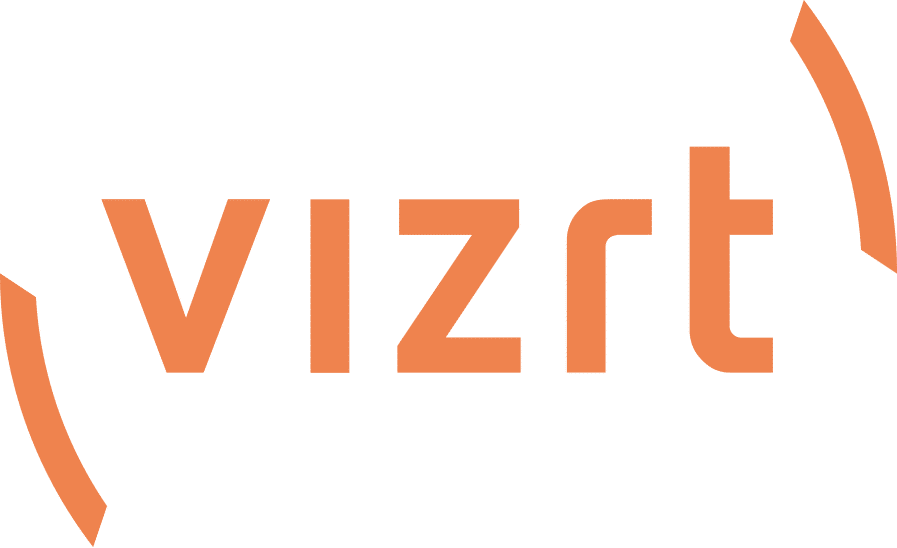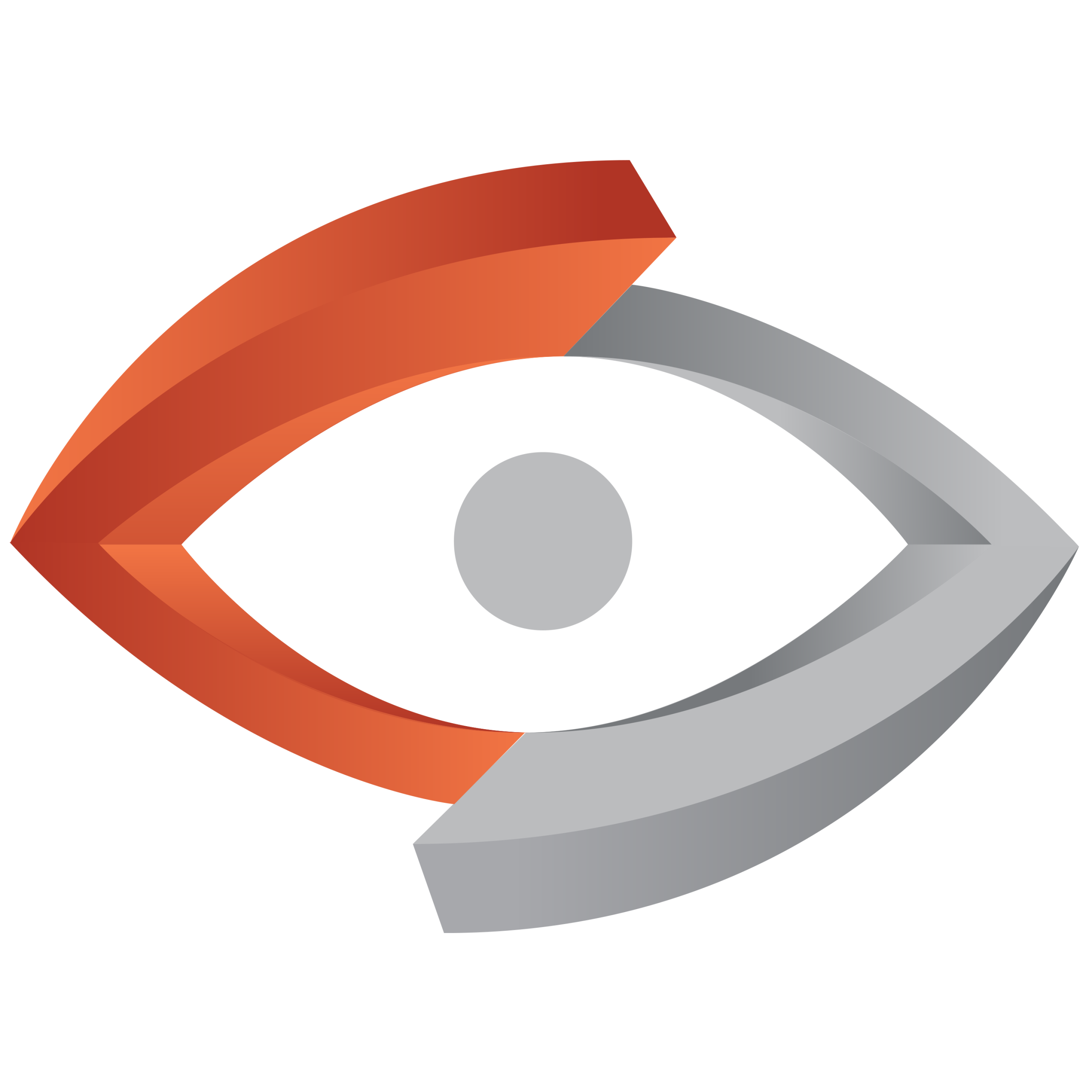By Russell Leak, Senior Pre-Sales Consultant EMEA at Vizrt
2024 is a big one for elections – a highly likely UK general election, a US election, and a few more. Elections are challenging for multiple reasons, but as we’ll see, they offer great storytelling and technical opportunities, and are an interesting use case for graphics. I’ve worked on a number of these election projects, mainly as a project manager, but there is so much involved to understand a client’s needs to deliver the desired outcome.
So, buckle up as we slide into battlegrounds, run around maps and immerse ourselves in a strange data-driven world where the experts are called “psephologists” and graphics are called “swingometers”, and where we watch graphics cards burn as votes are counted in real time.
First Lessons
My first election was in 2005, where I was commissioned to provide a virtual studio for the amazing Peter Snow. Peter was a phenomenon. I’d see him look in a small flip book with the years printed on the side just before a piece of camera, and then he would reel off facts from historical elections and create unforgettable stories to bring the graphics to life.
With a UK election, you have 650 constituencies, and graphically, each must be somehow represented with a 3D geometry – already a challenge for the most advanced Graphic Processing Unit (GPU) and render engines. Today’s graphics are even more complex. There is a need to color and animate graphics and bring in real-time data as results are revealed.
During a rehearsal at that first election in 2005, we attempted to animate numerous 3D objects moving from the floor of the VR set to a swingometer on the wall. When the director called for animation, the GPUs experienced a meltdown, resulting in the unintended slow-motion flight of the 3D objects. Despite our initial confusion, the gallery applauded, assuming the slow-motion effect was intentional. This unexpected outcome led us to reconsider how to deliberately animate the objects in slow motion for the actual show.
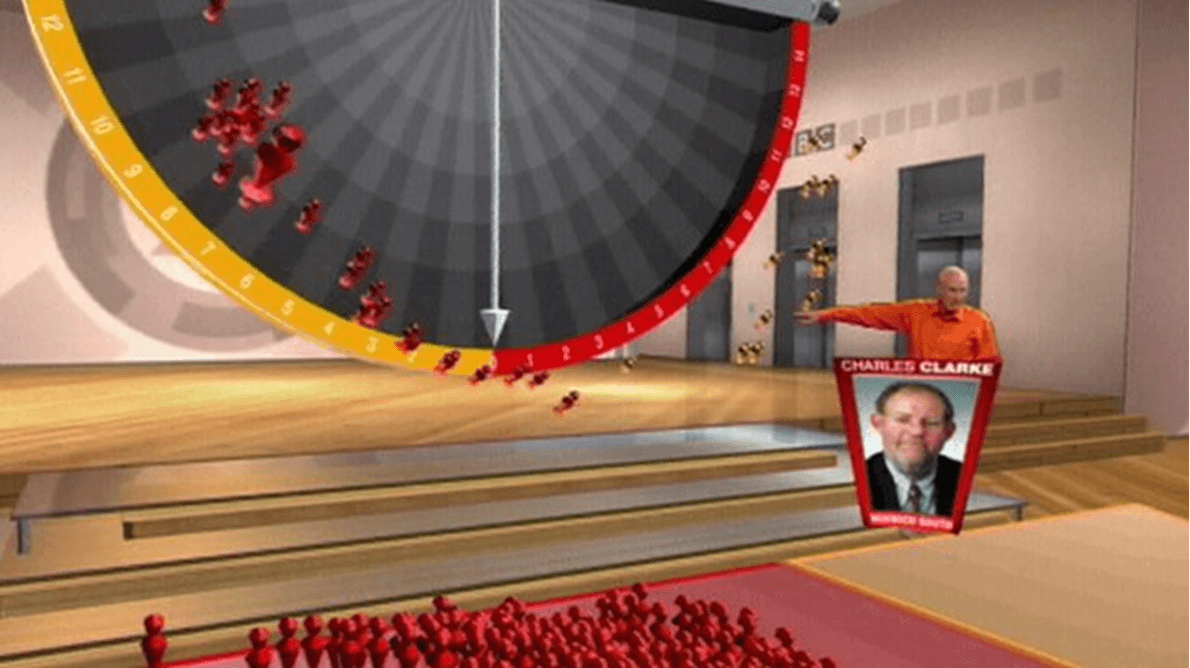
The lesson here? Being sure to test all your graphics ahead of time and with the hardware you will use for the actual show. I’ve often seen graphics working on the design workstation and then fail once all the other components are added, including data, tracking and control. If you want to watch some early Virtual Productions from 2005, including 3D scans of the various political leaders, you can watch them on YouTube.

That night, I also saw iconic English broadcaster Jeremy Paxman call up to television presenter Peter Snow from the studio below: “Hello old fruit. Is that a real policeman you have there or a virtual one?” Peter called the man over and said, “No, no, he’s real ….look.” Even back then, the real and the virtual worlds were merging. We then won a four-year contract to produce all BBC election shows, and things got serious.
Mix, matching, and stacking
When we first met and had a drink in the BBC bar, Peter Snow said he wanted a concept of stacked graphics. This is where graphics could be chosen from a list and stacked into the correct order according to how the story was developing. We could handle the animations between stacks and the data, but he and his producer could mix and match the stacks. He then would control each element of the stack himself using a clicker, live on the studio floor.
This setup worked well for Peter, allowing him to introduce the next graphic at his own pace. However, for other graphics, a different control approach was necessary. In this case, editors and producers, individuals closely connected to the story, took charge of controlling the graphics, diverging from the on-camera presenter or graphics operators’ role.
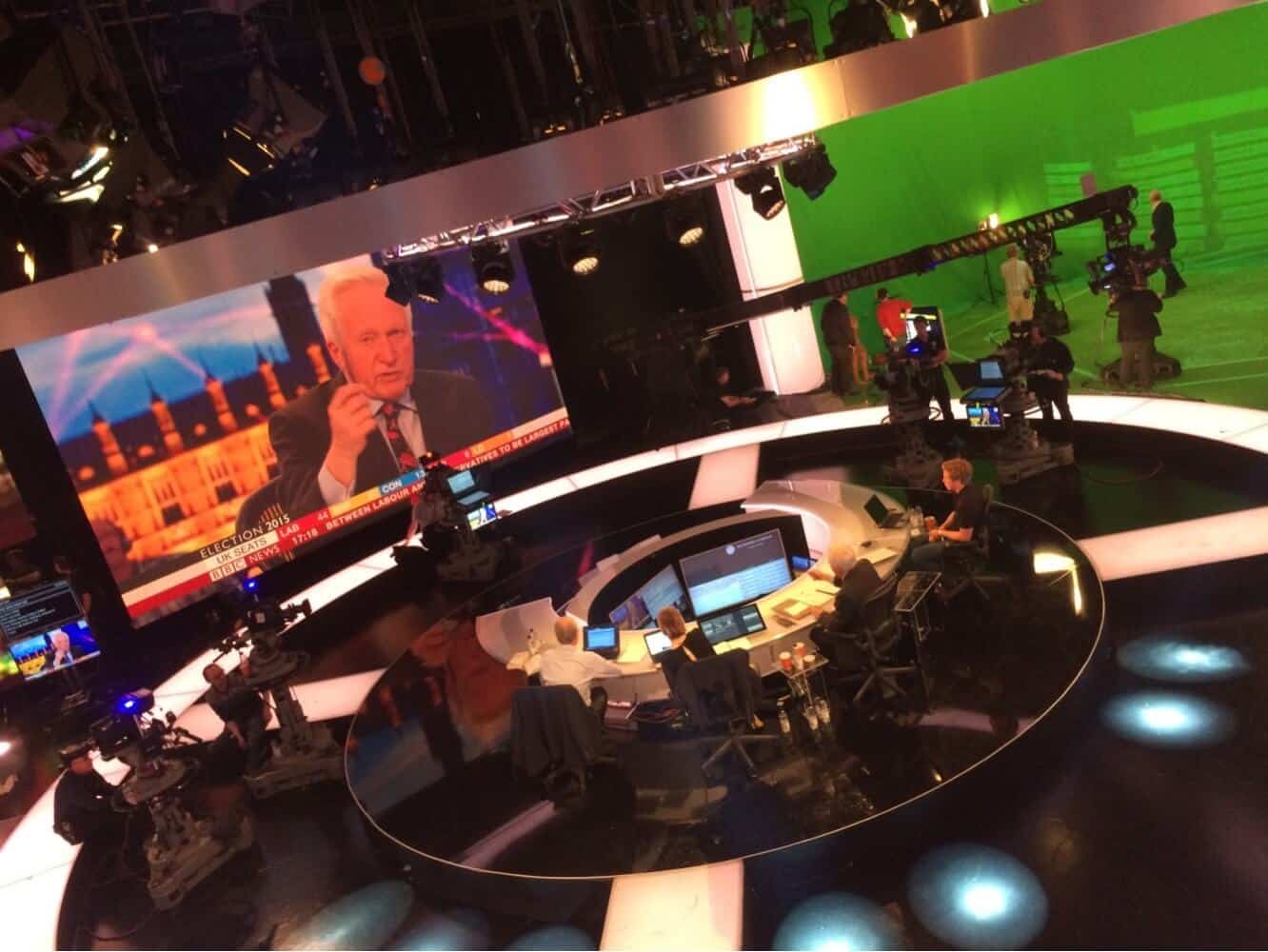
The control systems for the team behind the scenes would have to be very different, and the team would only get a little time to practice using them. They needed to be user-friendly, fast, and control graphics directly, with the touch screen a different interface altogether. Peter was keen to do the stacked graphics and the overall plan for the set was to be virtual.
Operating graphics or any equipment in a live show takes a lot of work, and there is a lot of pressure. Millions and millions of people watching that can affect people’s psyche. Press the wrong button or trigger the wrong graphic, and the mistake is seen, recorded and often shared on social media, lasting forever. Personally, I’ve caused a few of those cringe worthy moments myself over the years, and my kids love to remind me of them!
The takeaway from working with the BBC team for so many years, is that it’s important to build different controls for different users or applications, and to make them as easy to use as possible.
GRAPHICS, GRAPHICS, GRAPHICS!
Before we continue with my stories in producing elections, it’s an excellent time to take stock of all the different forms of graphics used to tell election stories. You might know this already; in which case you can skip ahead. I’ve steered clear of defining the possible political details in each graphic, but instead focused on the type of graphics used.
Virtual Studio – Virtual Studios immerse the presenter within the graphics, or the environment, or both. Showing the actual seats where the politicians sit gives more relevance to the viewer, and having the presenter immersed and still engaging the audience helps to communicate some of the more complex political elements. Of course, the technical setup is more complex, involving camera tracking systems and green screens, but these setups have improved over the years.
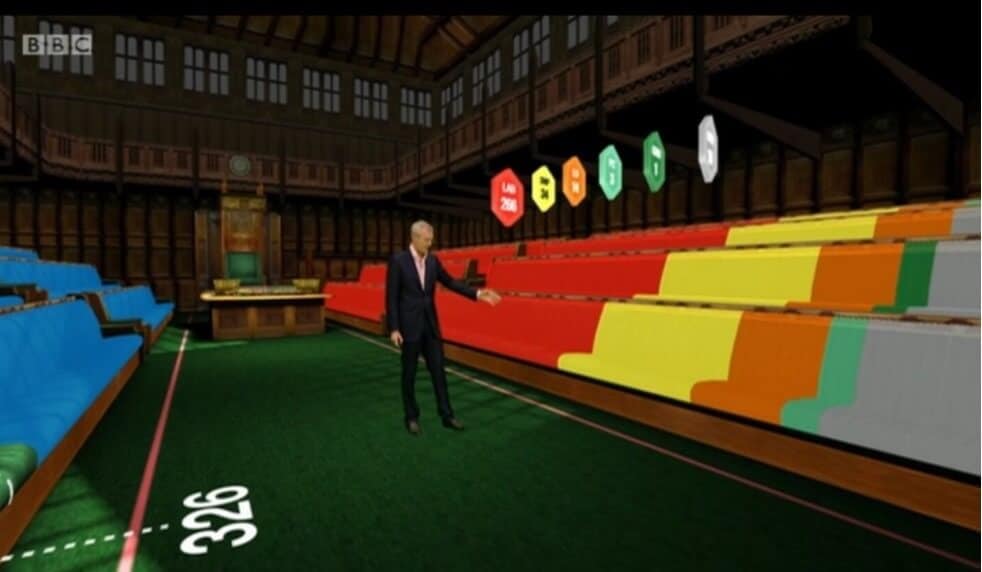
Augmented Reality – Adding virtual graphics into real studios helps to bring the studio alive while communicating to the audience. Using the benefits of a live location here is excellent to bring the audience to the event.

Lower thirds – Used for breaking news, seat calls, name straps and more.
Ticker – Part of the standard news suite of graphics, these are called in on an election night to cover ongoing news stories and updates.

Full forms – To display a breakdown of seat results and changes in voting behavior. They will often still keep a studio or OB shot as part of the graphic.

Touch screen – A way for presenters to show the facts and drill down deeper into the data themselves.
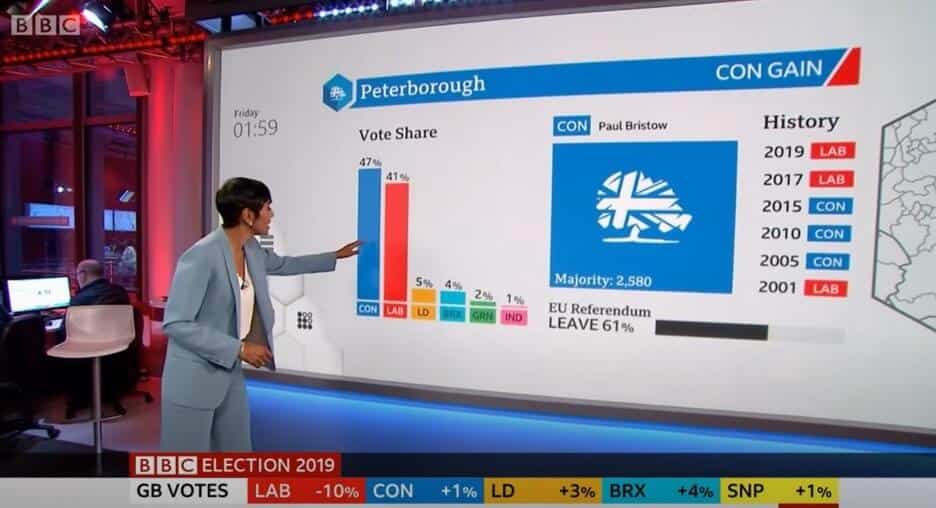
Drones – This offers a big-picture view of the studio or the outside environment. This visual impact enhances the overall viewing experience, making it more engaging, exciting and compelling for the audience.
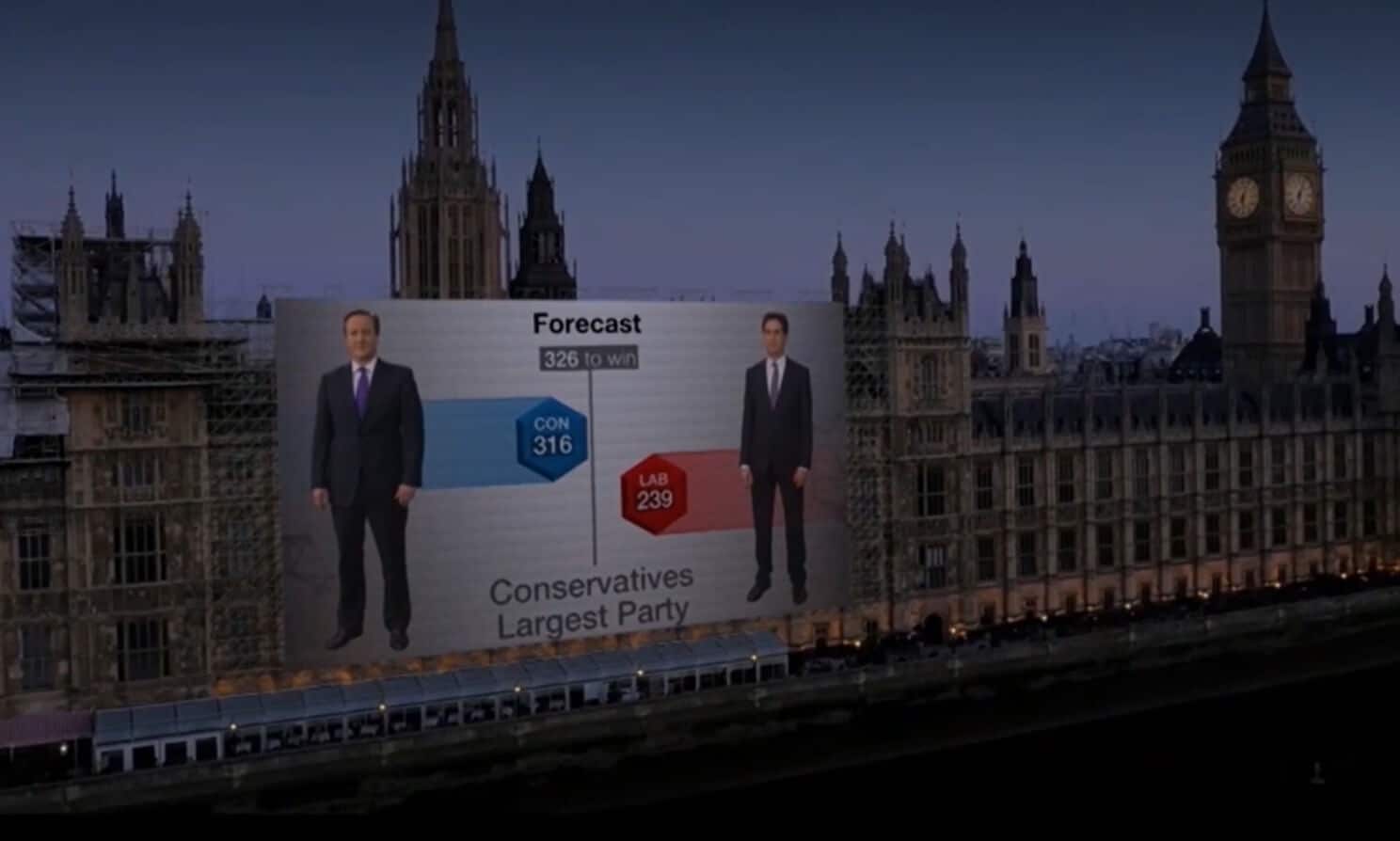
Architectural Projection – Similar to drones, it can set up a big-picture view for passers-by and the audience at home. Architectural projection creates a visually stunning and immersive experience. The sheer size can be awe-inspiring, capturing the attention of viewers and making a strong visual impact.
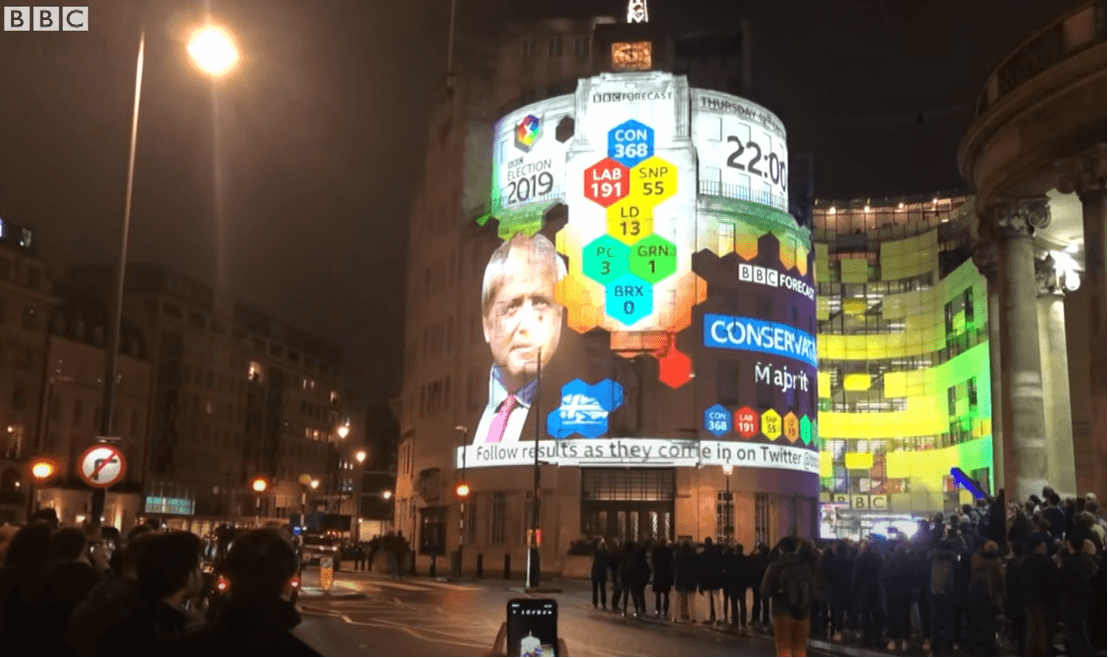
The 2015 BBC election featured AR, VR, touch screens, and all the above graphics, all being driven from data and controlled by different teams.

Tally – One of the most challenging graphics is the tally. This little beast has so much going on that it often gets overlooked. It keeps a running update of all the seats as they come in and must include all parties, not just the main ones. It often shows changes and percentages of the vote, all in a little screen real estate.
Swingometer – No UK election is complete without this graphic. It is a staple of UK elections and shows how far a vote has changed in favor of a new party. I remember after the first outing of the 2005 Swingometer, British politician Charles Kennedy said to Peter Snow in an interview: “Well…We know the election campaign has started today if your Swingometer is out!”
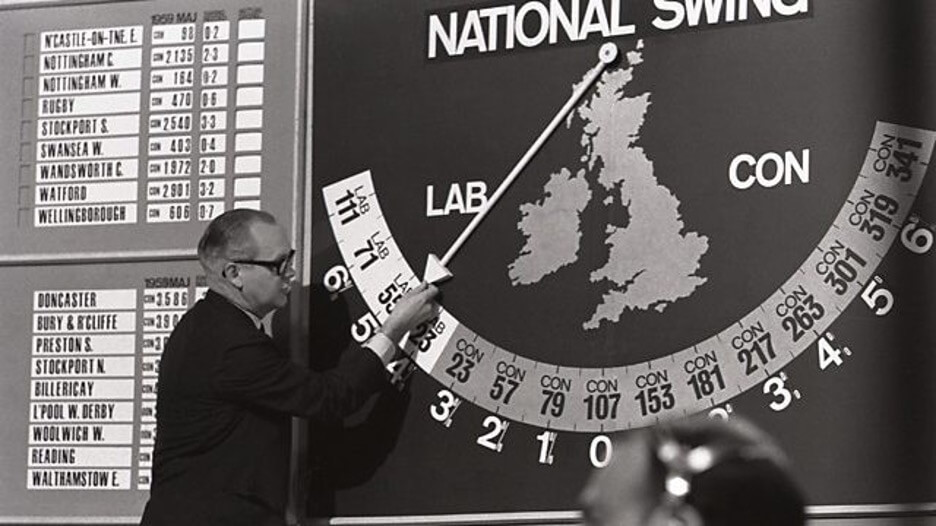
The Slapometer was a great parody of the famous graphic, meaning to vote with the back of your hand.
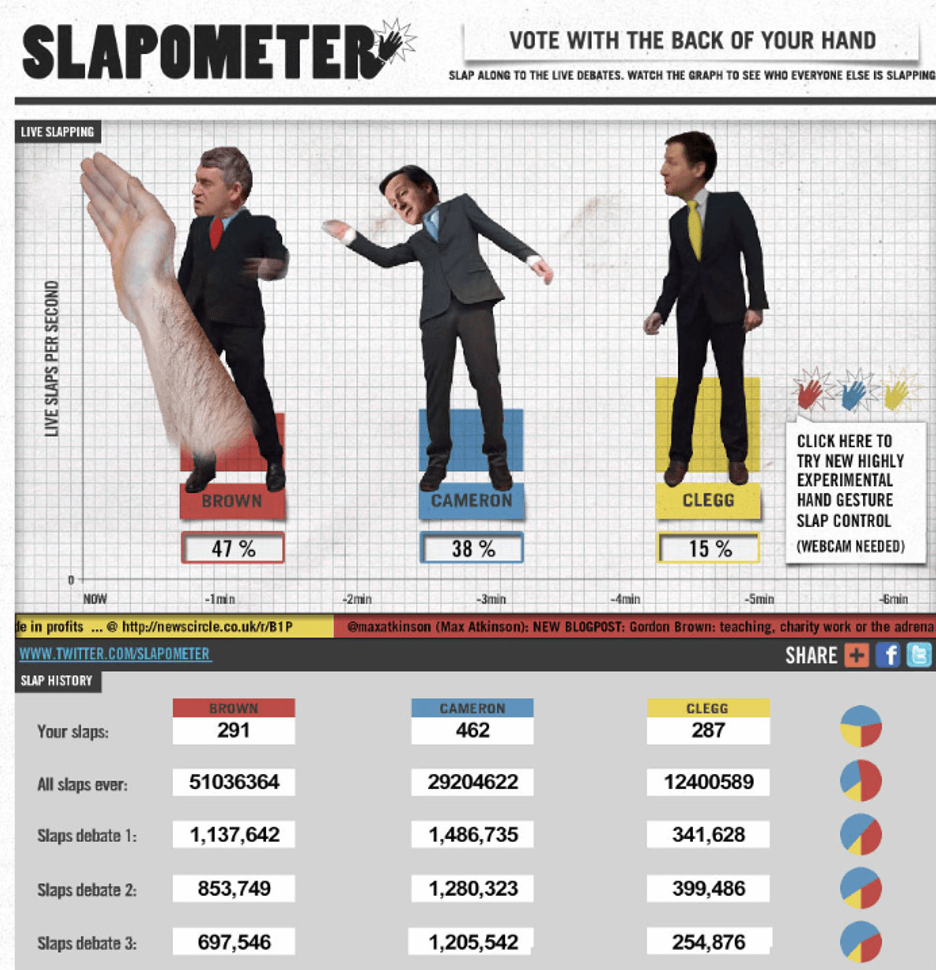
Extended reality graphics – For the BBC 2014 Scottish Referendum, there was the so-called “fish tank effect.” This gave the impression of depth on the screen by feeding the camera tracking system to an engine feeding the screen. Although it had been used way before this, it was a great use of the effect.
In this video, you can see the graphics fly out of the screen and in front of Jeremy Vine, combining XR and AR effects.

As you can see, one type of graphic does not fit all election productions, many different types of graphics are needed to bring the story alive. Considering which graphics are going to be most effective and most engaging for the story, is often what stresses and messes with people.
How do you choose which graphics to use for an election story?
Once, in an early planning meeting, the BBC’s Executive Producer suggested, “This is virtual. You can do anything you want.” Well, that perception is not quite true. Although virtual production and XR have come a long way recently, there are limits. Knowing those limitations and understanding the technology you want to use, then integrating the best quality and most reliable technology, are critical considerations in the election storytelling process.
And it will work well if you specify what you need and base it on priorities. I think Peter Snow originally coined the phrase “graphics bible”, which defines all the graphics scenarios and story points you plan to achieve in your live show. A graphics bible is essential for elections and honestly, beneficial for any live show using graphics.
Your graphics bible should consider, and ask the following questions, but by no means is a comprehensive list:
Entering the design and build stage: Creating election art
Any show’s overall design and look is an art form that requires time and effort. With all the discussion around generative AI, I still don’t quite see the possibility of this fully taking over the work. Augmenting it may be, but there is such a human component to how a show will look that I can’t see it right now.
Most of the 3D workflow for a virtual set involves bringing 3D files from a non-real time design programme to a real-time render. There are a few challenges with this, such as getting the textures to align and ensuring the model will work in real-time, but as the GPUs and the software have improved, that process is much more manageable.
For the 2D graphics, such as complete forms and lower thirds, design is often still done in After Effects and Photoshop and then has to be manually ported into the real-time engine. Tools like Viz Engine get you most of the way, but others still require manual adjustment of fine-tuning animations.
Building graphics within a real-time engine is a time-consuming task. Once the graphics bible is established, the team can then estimate the time required for construction, emphasising the importance of having a well-defined specification early in the process.
Considering the presenter is of the utmost importance
At the end of it all, you are telling a story that might change at any moment. The person in front of the camera telling the story is the primary connection between many jumbled numbers and the audience at home. If the presenters don’t feel comfortable, they cannot communicate. I realized early on that the better the tools to help presenters are, the better the show will be.
For example, working with Peter Snow, who was a long time presenter for the BBC, was fantastic. Sadly, he retired, but the amazing television presenter and journalist Jeremy Vine took over and embraced technology fully. It was always fun working with Jeremy. When working on a touch screen with Jeremy, I also realized that you should show the presenters all the technology and graphics early to help instill confidence.
That confidence must follow through to the final show. What can you do to give as much monitoring as possible? Jeremy would have monitors out of shot that could be customized to show information about the current graphic and a preview of the following graphic coming when he pressed the clicker.
Being on a green screen with no references can be disorienting, especially as the sets in an election might change. The clever guys at BBC Studios developed a system to project onto the green screen in blanking, meaning Jeremy can see it, but the camera can’t and, therefore, the keyer the person responsible for X, can’t. Jeremy could point to actual seats on a map and be sure it was reflected in the output.
Take a look at the 2017 set up from Jeremy himself, and this shot of me showing exactly that.

I also reached out to Jeremy Vine, an English television and radio presenter best known hosting BBC 2 Radio, who kindly provided some tips from a presenter standpoint:
You need to avoid looking into your monitors because it wrecks your eyeline. However, your monitors are the only sight you have of the view the graphics operation is giving the audience. There is no way around this, unless you wear sunglasses.

The great reporter Michael Crick once said that every television piece needs one fact and one joke, which also goes for graphics. Make sure you have at least one new fact in every graphics outing.
Technology moves more slowly than you think it does when you are doing live television. I was acutely aware that if I played Grand Theft Auto on my PC at home, it would have better graphics than any election program. But that is because a live TV program must not crash, not ever. GTA froze twice a day. You must accept that limitation. Also, GTA reportedly spent £35m building their graphics neighborhood. We have a lower budget! That said, sensationally, the last election I did was the first where the viewers actually thought I was standing outside, under the streetlamps of Downing Street itself.
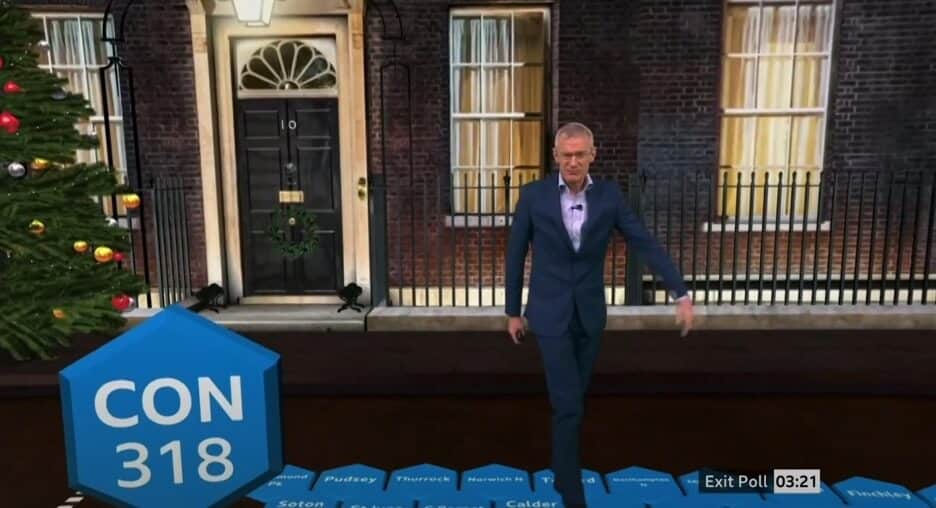
Jeremy makes a great point. As a technical aside, GTA does not need to be unlocked to all the other systems in the TV studio, and if it misses a frame, you hardly notice, but believe me, you notice immediately if the graphics on TV jitter even slightly.
It is an excellent testament to the broadcast TV graphics artists everywhere to say that what you see on TV is often created in a matter of weeks rather than the multi-year development that GTA has.
Separate monitors are often deployed for “now” and “look ahead” information so that the presenters know which data and which graphic is on air and what is coming up.
Chris Flye, a freelance broadcast graphics designer, has built many graphics, and he also shares a range of tips and considerations:
“Never give a touchscreen or iPad to a presenter to use live unless they know how to use it forwards and backwards. Work directly with them so they understand the graphics and the interface. Nothing looks worse than a presenter with a ‘rabbit in headlights look’ when they can’t use the kit.”
And also:
“Test, test, test! You can never test enough, and if the graphics are data-fed, double the build time.”
What technology is used in election productions?
Virtual Studio and Camera tracking – We talked earlier about the immersive properties of this technology. Getting the camera tracking right and the calibration done well is important. We would often have a presenter on a wide shot and then point to a particular area on a map that would be picked up on a different camera. So, both cameras must match in quality for consistency. It takes some time to calibrate the cameras and especially the lenses, so it’s always good to allow for this.
Presenter Tracking – It is sometimes desirable to track the talent in the studio space. This means we can automate some effects to make the presenter appear in front or behind graphics or trigger graphics automatically when a presenter reaches a certain area.

GPUs – As we saw in my early experiences, elections will test even the greatest GPUs. The latest technology offers some exciting capabilities for graphics processing, particularly virtual sets. If you can leverage the new features and performance of the newest generation of NVIDIA cards, you can release incredible features that aid in the quality of design and overall impression of the graphics.
Vizrt and NVIDIA have a brilliant white paper that discusses the RTX™ 6000 Ada Generation GPUs and how to get the best from them.
Touch Screens – These have gone out of fashion lately, but they still offer a great tool for presenter-led explanations where it’s possible to drill down further into the details of a story. There are various technologies available, with some better than others.
Returning to the confidence factor for presenters and Chris Flye’s tip, you sometimes see a presenter touch the screen a few times before the animation happens. This is where the sensor didn’t quite pick up the touch. It looks bad, and I can see why some presenters would be reluctant to use them. That said, the technology has improved in recent years.
LED Screens – This technology has also improved significantly, with dot pitch improving resolution and build quality helping to make it easier to set up and install. Reliability has also improved considerably.
There was one election where they hired all the available LED screens in the UK which had to be imported from Europe! There is much better availability these days, and the resolution has improved considerably with new technology, including Ghostframe making alternative effects and views available.
Just at the start of one live show, as the exit poll was revealed on the screen behind the main presenter, a large chunk of the screen went black. The director was gesticulating and burning the talkback with, “Let’s lose that bad graphic, please!”. ” I checked our local monitor, and all was good. It was the LED. Meanwhile, I spotted an army of engineers climbing ladders to replace components quickly.
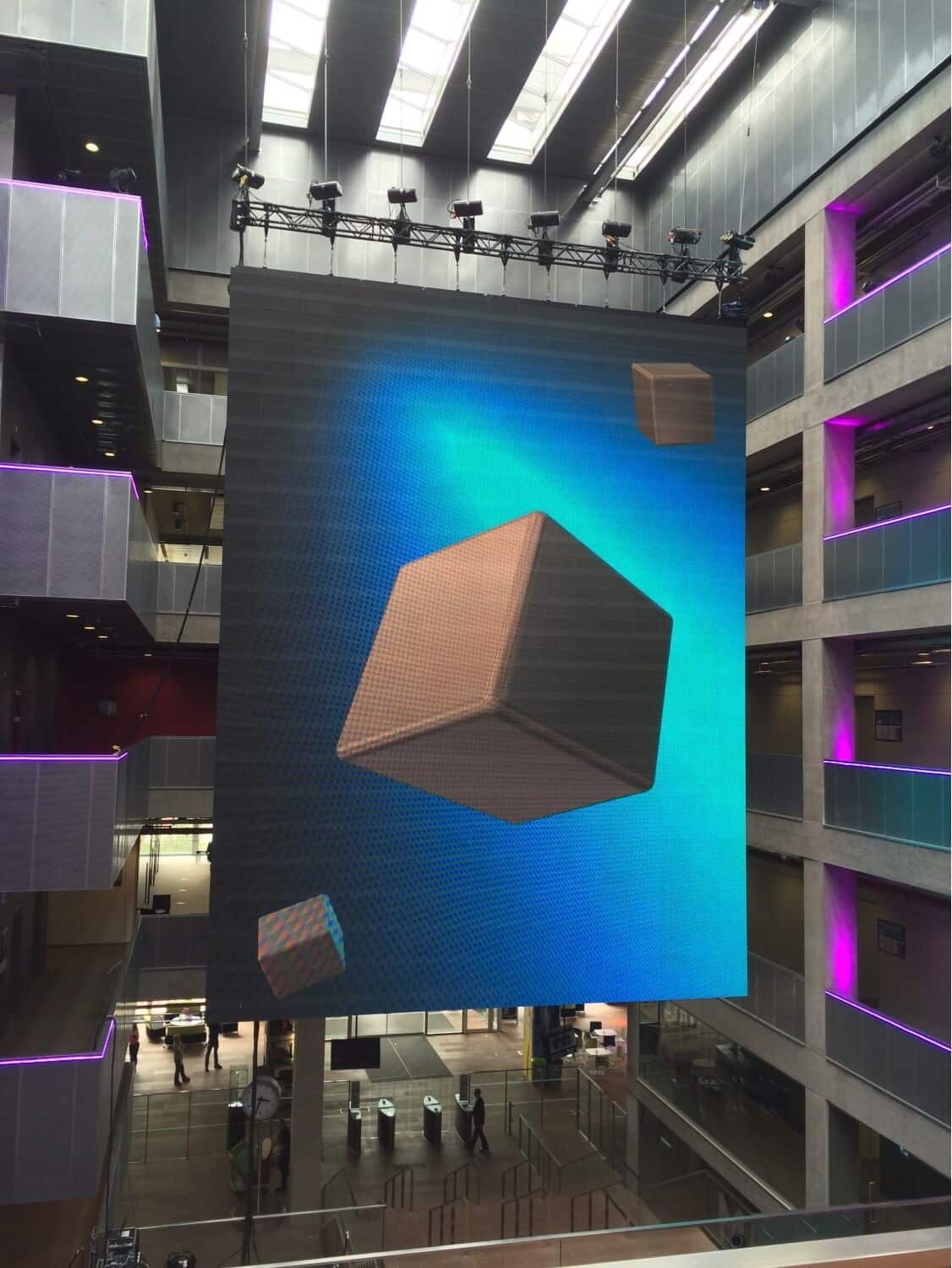
Going back to the Scottish Referendum, there was a huge LED hung from the ceiling of Pacific Quay and it looked stunning. It took a herculean effort to hang it, and I won’t forget the sad look on the Project Manager’s face when just one panel in the middle went black and the idea that the whole screen may have to be rebuilt.
I also remember standing shocked later as an engineer abseiled down the back of the screen to fix the faulty controller. He told me later that he was one of only three engineers in the UK qualified to do so!
Thankfully, that reliability has improved over the years, and can maintain and replace parts in a large wall. Big screen technology combined with camera tracking provides some exciting opportunities for XR.
Considering locations for election production
This also leads us to think about the space where all this technology goes, what type of studio will be used? It’s great to think about how that setting will serve your story and which technology is needed for these big shows.
Adi Strichman has been involved in many elections with over 20 years of experience at TV2 and he’s now at Danmarks Radio. I worked with him on the Danish Election in 2015. This is his tip on studio space:
“Location: Choosing an in-studio location allows for better control over your technical setup, while an outdoor location can enrich your scene with real-life, recognizable elements like well-known landmarks or the parliament building. However, if you opt for an in-studio setting, you can now, more than ever, add these kinds of backgrounds virtually. This approach enhances the visual appeal and allows for varied scenery throughout the show.”
Finally, it’s important to NOT use technology for technology’s sake. It’s essential to think about how technology serves the story.
Communication is just important as the technology
Communication starts well before the broadcast. Going back to our graphics bible, regular workshops will help align all the teams. In most of the post-rehearsal meetings I’ve been in, many issues concern communication or the lack or difficulty of it. As in most teams, the production centers around clear and good communication.
Here is another tip from Adi: “Vision and Communication – no matter your approach, internal communication within your team is the key to success. This involves consistent and clear coordination from the head of news to the head of design, from the designers to the build team, and between everyone involved, right up to the studio anchor. Ensuring everyone is on the same page and aware of the overall vision is crucial for a seamless and successful broadcast.”
You’ve guessed it. This goes back to having that key document or bible to drive the overall vision and success.
The importance of data for producing elections
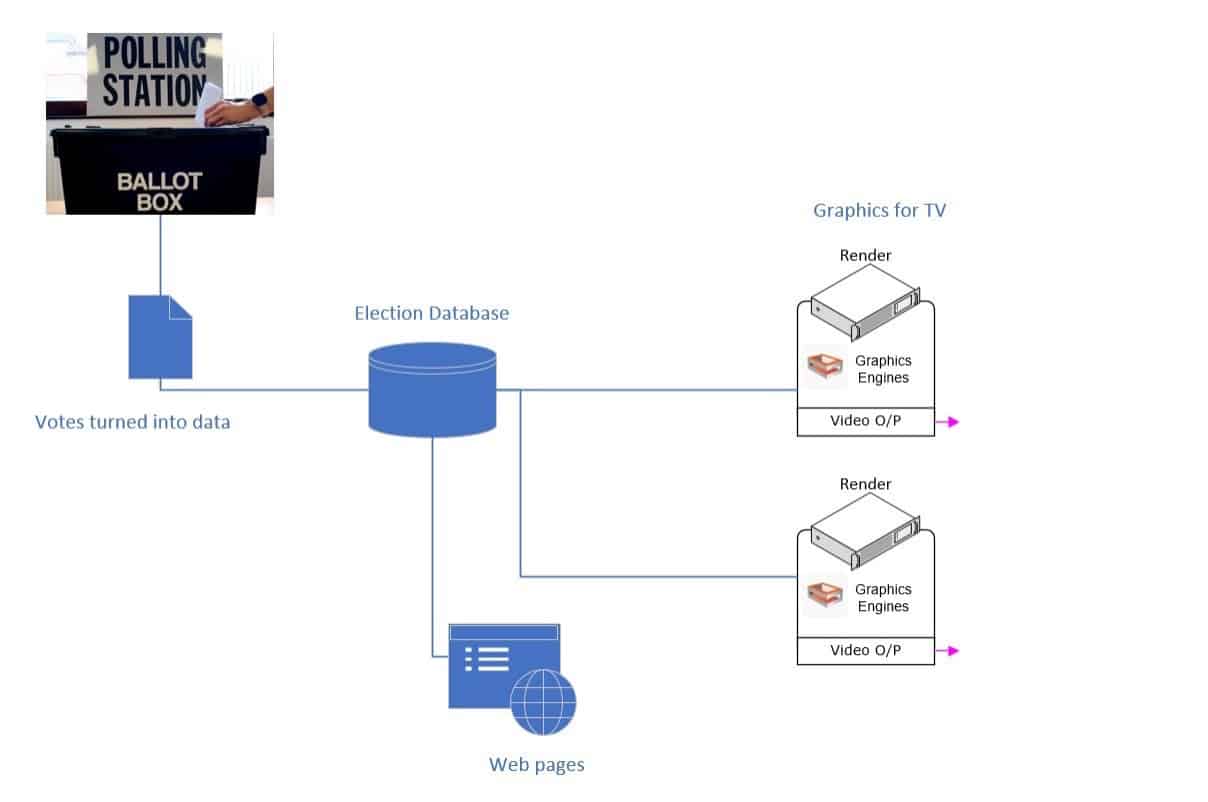
An election is one of those occasions where data is everything. The show is unfolding live as the votes are being counted. If the data fails, you’ve got no show.
You may get data in a format that does not help your graphics output. Many broadcasters employ companies to handle the data. Once again, the graphics bible should drive the data requirements. If the story suddenly becomes about the swing to a new party, but you don’t have that data, then you can’t tell that story.
A good lesson is to get a data sample early on and connect it to some graphics, see how it looks, and see how you want it to be represented.
Again, advice from Adi: “Data Management: Having full control over your data is crucial. Invest time in thorough testing to ensure reliability. Ultimately, the data forms the backbone of your show – it’s fundamental for painting an accurate picture of the election and it is what your audience will use to judge your timeliness and precision. Remember, it’s this data that drives the narrative of “winners and losers” in the election.”
It’s good to check where the data will be used as well. Depending on the output platform, it may change how data is displayed or the timing of the data. One of the tips from Richie Butler of Elect Systems:
“If passing on data to say, an online provider, then check what calls they are doing with the data, nothing worse than one system saying one thing, and another saying something different.”
Data is tough to manage, which is why, in the big shows, you have companies running that job for you. For simpler results and stories, the data requirements are less. Tools for this are improving all the time, and Vizrt has a nice new tool called Datacenter that helps to filter data and get it into your graphics.
The biggest lesson is to tell a story
Why do any of this? It’s all about telling an exciting story as it unfolds in real-time, and technology has to serve that purpose somehow.
As well as looking good and being visually engaging, it has to be fast, both in rendering speed for complex graphics and in updating data, and finally how you control those graphics and get them on air.
My biggest lesson from election shows is that “no plans survive contact with the enemy” and to be prepared and to expect the unexpected. This has become a good tip for most live shows I’ve been involved with. It’s still important to plan, make a specification (graphics bible), build priorities, and ensure everyone is aligned with a common goal.
To effectively navigate the constantly evolving political narrative, it is essential to use cutting-edge technology and respond promptly to the dynamic nature of the story.
I’m looking forward to this year to see what complex stories and great showcases we’ll see across our screens. As the leader in real-time graphics and live production solutions for content creators, we’re experts in helping to define and reshape the way video is created and shared with the world.
If you’re looking for a ground-breaking solution that can take your production to the next level, get in contact with our team of experts here.
